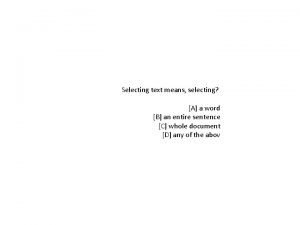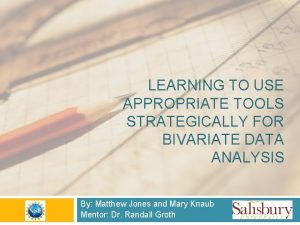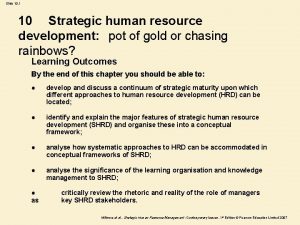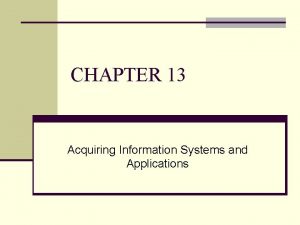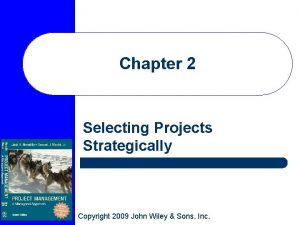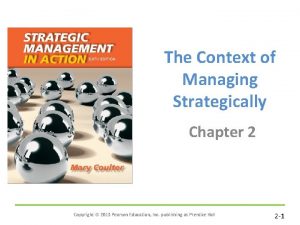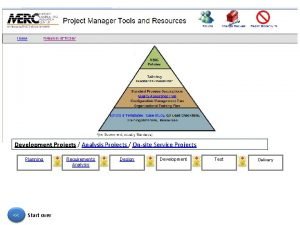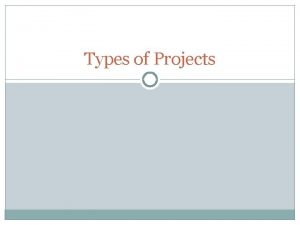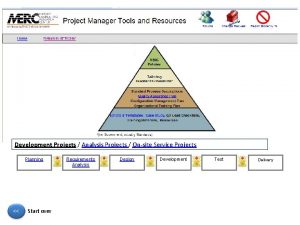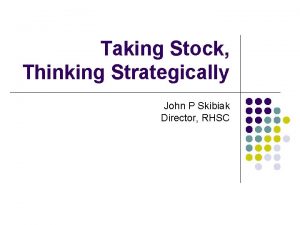Chapter 2 Selecting Projects Strategically Copyright 2009 John





























- Slides: 29

Chapter 2 Selecting Projects Strategically Copyright 2009 John Wiley & Sons, Inc.

Problems With Multiple Projects 1. 2. 3. Delays in one project delays others Inefficient use of resources Bottlenecks in resource availability

Challenges Making sure projects closely tied to goals and strategy l How to handle growing number of projects l How to make projects successful l

Project Management Maturity Project management maturity refers to mastery of skills required to manage project competently l Number of ways to measure l Most organizations do not do well l

Project Selection and Criteria of Choice l Project selection… – Evaluating – Choosing – Implementing

Types of Companies l Companies considering projects fall into two broad categories: 1. 2. l Companies whose core business is completing projects Companies whose core business is something else They can also be broken down as: 1. Companies do projects for others 2. Companies do projects for themselves

Project Companies l l Must select which projects they will bid on Generally based on… – Their expertise – – l l Resource they have availability Their chance of winning bid Preparing a bid is expensive They do not want to waste that effort on unsuccessful bids

Non-Project Companies Must decide which potential projects they will pursue l Available capital is the major constraint l Profitability is often the major criteria l

Models l l Models are used to select projects Looking at the key variables in a decision Stochastic Model (probabilistic model) – A model that includes the probabilities of events – Inputs might yield different outputs at different times Deterministic Model (non-probabilistic model) - A model that does not include probabilities. - Inputs will always yield same output at different times.

Criteria For Project Selection Models Companies only want to undertake successful projects to avoid wasting resources, profitability and competitiveness Challenges to this criteria l It is not possible to know ahead of time if a project will succeed or fail l No model can predict with absolute certainty (The explosion of the Challenger) l

Model Criteria Realism l Capability l Flexibility l Easy to use l Inexpensive l Easy to implement l

Types of Project Selection Models Nonnumeric models l Numeric models l

Types of Nonnumeric Models l Sacred Cow – l Operating Necessity – l A project that is suggested by top management, without any justification A project that is required to keep the company in operation. Competitive Necessity – A project that is required to maintain the company’s position in the marketplace.

Types of Nonnumeric Models l Product Line Extension – l Continued A project that is required to expand a product line Comparative Benefit – A project that is required for its perceived benefit to the company.

Numeric Models: Profit/Profitability Models l Models that look at costs and revenues – – Payback period Net present Value (NPV) or Discounted cash flow

Payback Period The length of time until the original investment has been recouped by the project l A shorter payback period is better l

Payback Period Formula

Payback Period Drawbacks 1. 2. 3. Time value of money is not considered More difficult to use when cash flows change over time Less meaningful over longer periods of time (due to time value of money)

NPV Formula Terms A 0 Ft k T l l Initial cash investment (negative) (e. g. , 100, 000) The cash flow in time period t (e. g. , 25, 000/year) The discount rate (rate of return (e. g. , 0. 15), inflation rate (e. g. , 0. 03), etc) The number of years of life (8 years) A higher NPV is better The higher the discount rate, the lower the NPV

t (1+k)t F F / (1+k)t 1 2 1. 18 1. 392 25000 21186. 4 17954. 6 3 4 5 6 7 8 Total NPV= 1. 643 1. 939 2. 288 2. 700 3. 186 3. 759 25000 25000 15216. 1 12894. 7 10927. 5 9260. 6 7848. 1 6650. 9 101, 938. 7819 - 100, 000 + 101, 938. 7819 = 1938. 78 = 1939

NPV Example

Scoring Models Unweighted factor model l Weighted factor model l

Unweighted Factor Model Each factor is weighted the same l Less important factors are weighted the same as important ones l Easy to compute l Just total or average the scores l

Unweighted Factor Model Example

Weighted Factor Model l Each factor is weighted relative to its importance – l l Weighting allows important factors to stand out A good way to include non-numeric data in the analysis Factors need to sum to one All weights must be set up so higher values mean more desirable Small differences in totals are not meaningful

Weighted Factor Model Example

Project Portfolio Process (PPP) Linking projects to goals and strategy of the organization as a mean for monitoring and controlling PPP Steps l 1. 2. 3. 4. 5. 6. 7. 8. Establish a project council Identify project categories and criteria Collect project data Assess resource availability Reduce the project and criteria set Prioritize the projects within categories Select projects to be funded and held in reserve Implement the process

PPP Steps 1. 2. 3. 4. 5. 6. 7. 8. Establish a project council Identify project categories and criteria Collect project data Assess resource availability Reduce the project and criteria set Prioritize the projects within categories Select projects to be funded and held in reserve Implement the process

Project Proposal Contents (A project bid) Cover letter l Executive summary l The technical approach l The implementation plan l The plan for logistic support and administration l Past experience l
 Selecting text means
Selecting text means Potential development projects can be identified by
Potential development projects can be identified by Managing strategically
Managing strategically Use appropriate tools strategically
Use appropriate tools strategically Measurement in staffing
Measurement in staffing Strategically oriented cycle of hrd activities
Strategically oriented cycle of hrd activities 2009 pearson education inc
2009 pearson education inc International color standards
International color standards Dell all rights reserved copyright 2009
Dell all rights reserved copyright 2009 Copyright 2009 pearson education inc
Copyright 2009 pearson education inc Diffrazione luce zanichelli
Diffrazione luce zanichelli Copyright 2009
Copyright 2009 Copyright 2009
Copyright 2009 Copyright 2009 pearson education inc
Copyright 2009 pearson education inc 2009 pearson education inc
2009 pearson education inc Copyright 2009 pearson education inc
Copyright 2009 pearson education inc 2009 pearson education inc
2009 pearson education inc Chapter 17 eggs selecting and storing eggs
Chapter 17 eggs selecting and storing eggs Chapter 7 selecting the channel members
Chapter 7 selecting the channel members Chapter 5 selecting a topic and a purpose
Chapter 5 selecting a topic and a purpose Chapter 5 selecting a topic and a purpose
Chapter 5 selecting a topic and a purpose Hris steps
Hris steps Investment risk example
Investment risk example Squint test is used as a guide for selecting teeth
Squint test is used as a guide for selecting teeth Logical view of data in dbms
Logical view of data in dbms Indirect cost of expatriate failure
Indirect cost of expatriate failure Selection of delta
Selection of delta While driving in urban situations
While driving in urban situations Selecting investment in global market
Selecting investment in global market Steps for selecting and acquiring an information system
Steps for selecting and acquiring an information system
